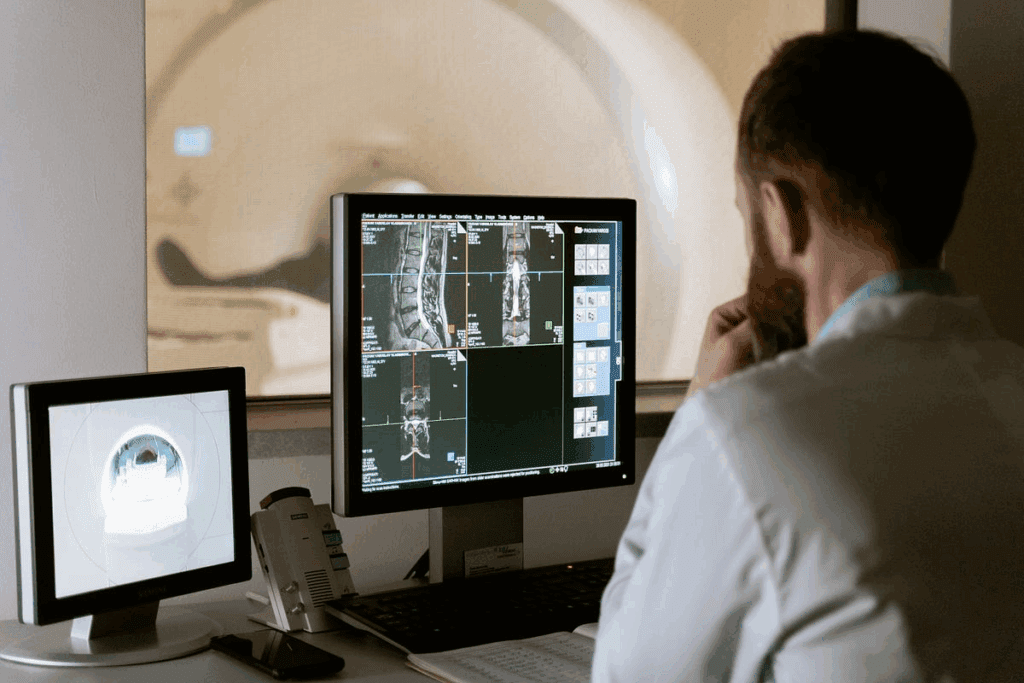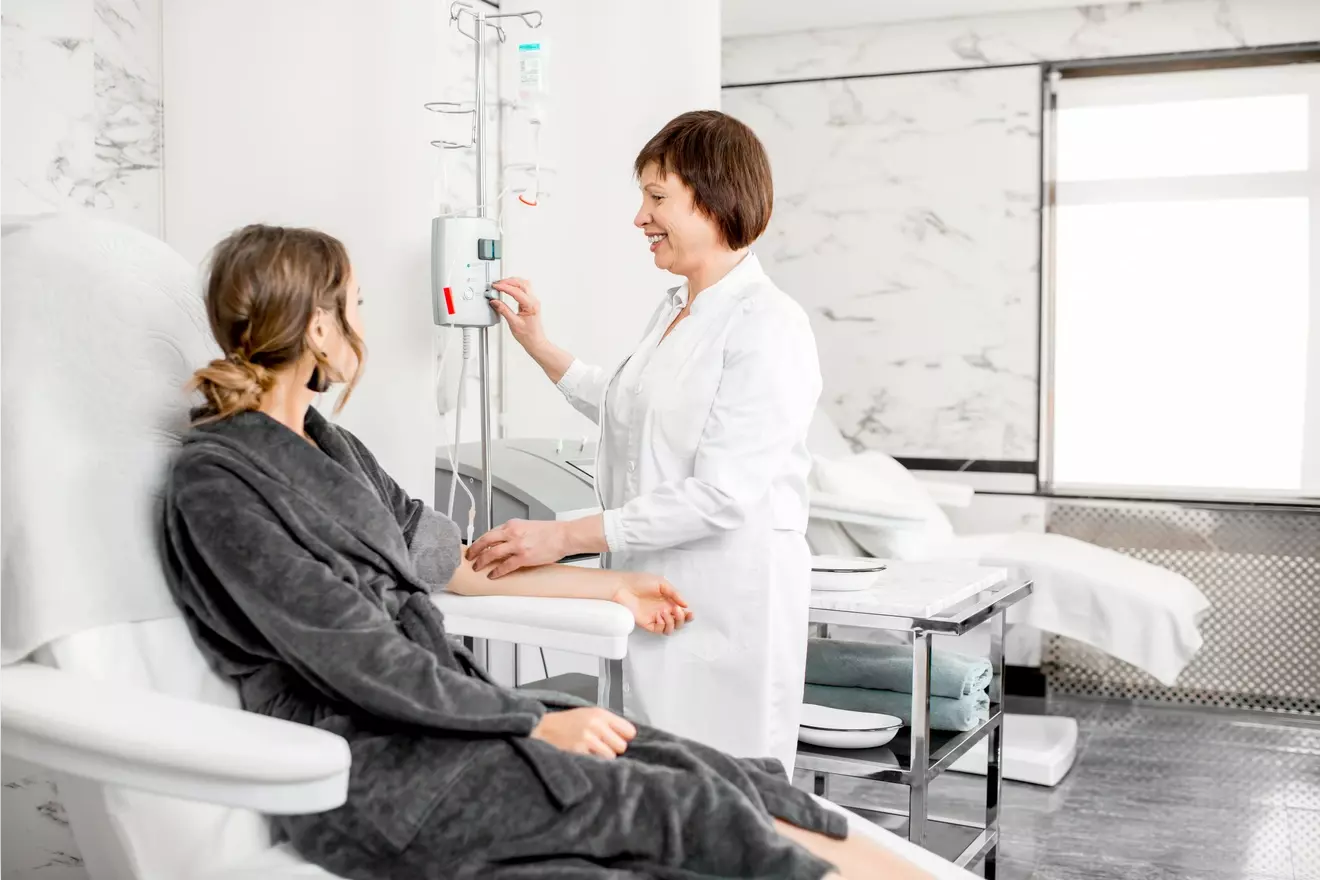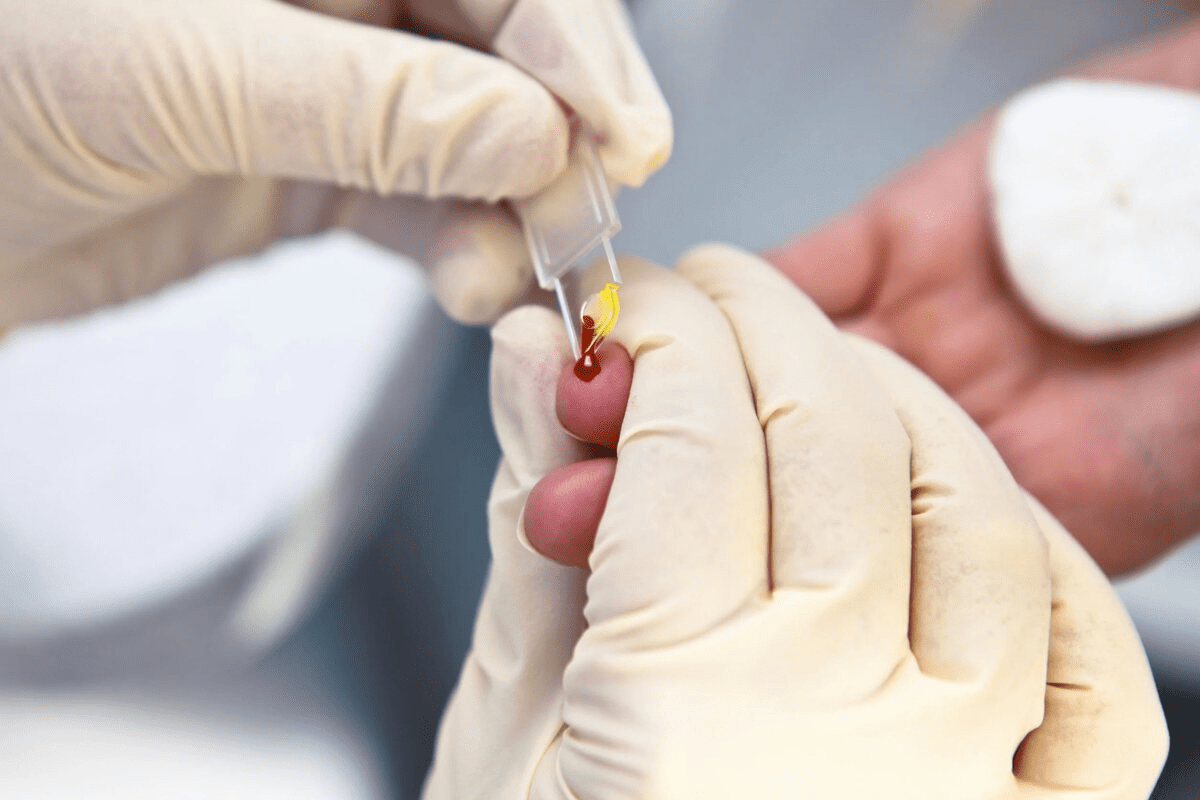Last Updated on November 26, 2025 by Bilal Hasdemir

We are seeing a big change in healthcare thanks to artificial intelligence (AI). AI is helping doctors find diseases earlier and more accurately. It also makes patient care more personal and makes clinical work easier. See how AI is changing medical imaging diagnosis. Discover 7 amazing trends that are revolutionizing healthcare and diagnostics.
Places like Liv Hospital are using advanced AI tools with strong cybersecurity. This mix is changing how we do medical imaging and keeping patient data safe.
Key Takeaways
- AI is changing medical imaging diagnosis by making it more accurate and fast.
- AI and cybersecurity together protect patient data.
- Institutions like Liv Hospital are leading in this technology.
- AI is making patient care more tailored to each person.
- The AI in medical imaging market is expected to grow a lot.
The Current State and Future of AI in Healthcare Imaging

AI is changing how we diagnose diseases. It’s making healthcare diagnostics better with new AI technologies.
The USD 1.36 Billion Market is Growing to USD 20 Billion by 2033
The AI in medical imaging market is expected to grow a lot. It will go from USD 1.36 billion in 2024 to nearly USD 20 billion by 2033. This shows how much we’re counting on AI to make diagnoses better and faster.
AI, like machine learning and deep learning, is making diagnoses more precise and efficient. The market is growing because we need quicker and more accurate tests. Deep learning algorithms, like convolutional neural networks, are key. They can diagnose with over 95% accuracy in many important cases.
Drivers Behind the Rapid Adoption of AI Technologies
Several things are making us use AI in medical imaging more. We need better diagnoses; there’s a lot of imaging data, and not enough skilled radiologists. AI can quickly and accurately analyze complex data. It’s becoming a must-have in healthcare.
AI in medical imaging is not just making diagnoses better. It’s also making workflows more efficient. AI automates simple tasks, letting radiologists work on harder cases. This makes them more productive.
Enhanced Disease Detection: AI’s Role in Early Diagnosis

AI plays a key role in improving disease detection, bringing unmatched accuracy to medical imaging. We’re seeing a big change in how diseases are found and diagnosed. This is all thanks to AI’s role in medical imaging.
Pattern Recognition Beyond Human Capability
AI is being used in many medical fields, like oncology, dermatology, and cardiology. It helps find diseases early. These models use advanced algorithms to spot patterns in medical images that humans can’t see.
AI’s ability to recognize patterns is unmatched by humans. It allows for:
- Improved sensitivity in spotting abnormalities
- More accurate disease diagnosis
- Quicker analysis of medical images
With AI, doctors can find diseases sooner. This leads to better patient care and less disease burden.
Clinical Impact of Earlier Disease Identification
Spotting diseases early has a big impact on healthcare. It lets doctors:
- Start treatment plans sooner, which can improve patient outcomes
- Lower the risk of disease getting worse
- Improve patient quality of life with timely care
AI in medical imaging is changing the game. It’s making disease detection earlier and more accurate. As AI gets better, we’ll see even more progress in patient care.
Accelerating Medical Imaging Diagnosis with AI Assistance
The use of AI in medical imaging is changing how we diagnose diseases. It makes diagnosis faster and more accurate. This is a big win for patient care.
How Radiologists Achieve 25% Faster Interpretation Times
Radiologists using AI can interpret images up to 25% faster. This is a big deal for patient care. AI quickly goes through lots of data, spotting things humans might miss.
AI can preliminarily analyze images and point out important areas. This makes the radiologist’s job easier and more accurate.
- AI-assisted detection of abnormalities
- Rapid analysis of large imaging datasets
- Enhanced precision in diagnostic reporting
Workflow Optimization in High-Volume Imaging Centers
In busy imaging centers, AI is a game-changer. It makes the workflow more efficient. AI does the initial analysis, freeing up radiologists for tough cases.
“AI is not just a tool; it’s a collaborative partner that enhances our ability to provide timely and accurate diagnoses.” – An Expert Radiologist
AI makes the workflow better in many ways:
- Reduced patient wait times
- Increased productivity among radiologists
- Improved overall quality of care
As AI gets better, it will play an even bigger role in making diagnoses faster. This will change how we do medicine.
Deep Learning and CNNs: The Engine Behind 95%+ Diagnostic Accuracy
Deep learning, mainly through CNNs, is now driving over half of AI in medical imaging. It has reached unmatched diagnostic accuracy. This marks a big change in how medical images are analyzed and understood.
Transforming Image Analysis with CNNs
Convolutional Neural Networks (CNNs) have changed image analysis. They can spot subtle patterns and abnormalities that humans might miss. CNNs can process complex medical imaging data, reaching diagnostic accuracy over 95% in key conditions.
The CNN architecture is key. It extracts features from images efficiently and effectively. This is vital in medical imaging, where spotting small details can mean the difference between a correct or incorrect diagnosis.
AI vs. Human Radiologist Performance
Research shows AI can match or even beat human radiologists in accuracy. Here’s a comparison of AI systems using CNNs and experienced radiologists:
| Diagnostic Task | AI Diagnostic Accuracy | Human Radiologist Accuracy |
| Tumor Detection | 96.2% | 94.5% |
| Fracture Identification | 95.5% | 93.2% |
| Vascular Disease Diagnosis | 97.1% | 95.8% |
The table shows AI systems using CNNs have high diagnostic accuracy. They often do better than human radiologists in certain tasks. This shows deep learning’s big promise for medical imaging.
Personalized Medicine Through AI-Enhanced Imaging Analysis
AI is changing personalized medicine by making treatments more precise. It helps us analyze each patient’s data to create custom plans. This leads to better health outcomes for everyone.
Tailoring Treatment Plans Based on Individual Imaging Profiles
AI can look at complex images to find what makes each patient unique. This lets doctors create treatments that are more likely to work.
For example, AI can find specific genetic changes in patients. It then suggests treatments that target those changes. This makes treatments more effective and improves patient results.
| Imaging Modality | AI Application | Clinical Benefit |
| MRI | Tumor segmentation | Precise treatment planning |
| CT Scan | Disease progression analysis | Early intervention |
| X-ray | Fracture detection | Accurate diagnosis |
Predictive Analytics for Treatment Response
Predictive analytics is key in AI-enhanced imaging. AI looks at past data and current images to guess how a patient will react to treatment.
This helps doctors change treatment plans as needed. It ensures patients get the best care possible.
For instance, AI can guess how well a tumor will respond to chemo. This helps doctors avoid treatments that won’t work and saves money.
4D Imaging and Real-time Disease Monitoring Innovations
4D imaging is changing healthcare by letting doctors watch how diseases grow in real-time. This new tech is changing how we find and treat diseases. It gives us a better look at what’s happening inside our bodies.
Moving Beyond Static Images to Dynamic Visualization
Old medical images just show a single moment. But 4D imaging shows how things change over time. This lets doctors see how diseases grow and how treatments work. Real-time disease monitoring is now possible, helping doctors make quick and smart choices.
A recent study found that using 4D imaging in hospitals could really help patients. It could lead to earlier and more accurate treatments.
“The future of medical imaging lies in its ability to provide real-time, dynamic data that can be used to tailor treatment strategies to individual patients.”
Clinical Applications of Temporal Imaging Data
4D imaging has many uses in medicine. It’s great for watching how the body changes over time. This is really helpful for managing long-term diseases, where knowing how the disease grows is key to good treatment.
| Clinical Application | Benefit of 4D Imaging |
| Cancer Treatment | Real-time monitoring of tumor response to treatment |
| Cardiovascular Diseases | Dynamic visualization of heart function and blood flow |
| Neurological Disorders | Detailed analysis of brain activity and structure |
With 4D imaging and real-time monitoring, we can really improve how we care for patients. As this tech gets better, we’ll see even more cool uses in medical imaging.
Blockchain-Secured Image Sharing and Data Integrity
Blockchain is making medical imaging data safer. We’re sharing more medical images than ever. Keeping this data safe and secure is now more important than ever.
Immutable Medical Imaging Records
Blockchain is being used to protect medical images. It makes sure data stays the same forever. Immutable records mean that once data is written to the blockchain, it cannot be altered or deleted, providing a permanent and tamper-proof record of patient imaging data.
Blockchain is becoming key in medical imaging to keep patient info safe. Its decentralized nature makes it hard for hackers to get to the data.
Facilitating Secure Cross-institutional Collaboration
Blockchain helps different healthcare places work together safely. It lets them share medical images securely. This improves patient care and results.
| Benefits | Description |
| Enhanced Security | Blockchain technology provides a secure way to store and share medical imaging data. |
| Immutable Records | Data written to the blockchain cannot be altered or deleted. |
| Improved Collaboration | Secure sharing of medical imaging data across different healthcare providers. |
Blockchain in medical imaging is growing fast. It’s all about keeping data safe and secure. By using blockchain, we can make sure medical imaging data stays safe, tamper-proof, and easy for the right people to access. This leads to better care for patients.
Med Cyber Security: Protecting AI Systems Processing Billion+ Annual Scans
AI in medical imaging is growing fast. This means we need strong cybersecurity. AI handles huge amounts of medical data, so we must protect it from cyber threats.
Med cyber security is key because AI handles over 1 billion patient scans each year. Keeping these systems safe is vital. It helps keep medical imaging data safe and private.
Comprehensive Security Frameworks for Imaging Networks
Protecting imaging networks needs a solid security plan. This plan includes several layers of defense. Here are a few:
- Network Segmentation: This isolates sensitive data and systems. It stops breaches from spreading.
- Encryption: This method protects data as it moves and when it’s stored. It keeps it safe from unauthorized access.
- Access Controls: Only people who should can access sensitive data and systems. This limits who can see or change it.
As noted by a cybersecurity expert,
“A multi-layered security approach is essential for protecting against the evolving landscape of cyber threats.”
| Security Measure | Description | Benefits |
| Network Segmentation | Dividing the network into secure segments | Prevents lateral movement, reduces breach impact |
| Encryption | Protecting data with encryption algorithms | Ensures data confidentiality, prevents unauthorized access |
| Access Controls | Restricting access to authorized personnel | Reduces risk of insider threats, ensures compliance |
Threat Detection and Prevention Strategies
Good threat detection and prevention are key to a strong cybersecurity plan. This includes:
- Anomaly Detection: This finds unusual patterns that might show a security threat.
- Intrusion Detection Systems: These watch network traffic for signs of unauthorized access.
- Regular Updates and Patching: Keeping systems current with security patches helps prevent known vulnerabilities from being exploited.
By using these strategies, we can make AI systems for medical imaging much safer. As the field grows, we must stay alert and update our security plans to face new threats.
Conclusion: Embracing the AI Revolution in Medical Imaging
We are seeing a big change in healthcare, thanks to AI in medical imaging. This change helps find diseases early and tailor care to each patient. It leads to better health results.
AI’s role in medical imaging is growing. It can look at complex data and help doctors make accurate diagnoses. This leads to better treatment plans for patients.
But, there are challenges like keeping data safe and avoiding bias in AI. We need to solve these problems to use AI’s full power in healthcare. By doing this, AI can keep improving medical imaging, leading to better care and health for everyone.
FAQ
References
What is the current state of AI in medical imaging?
AI in medical imaging is growing fast. It’s being used to make diagnoses quicker and more accurate. This helps doctors give better care and work more efficiently.
How is AI revolutionizing disease detection in medical imaging?
AI is changing how we find diseases early. It’s helping doctors spot problems sooner. This leads to better health outcomes and less disease burden.
What is the role of deep learning in medical imaging diagnosis?
Deep learning, like CNNs, is key to AI’s success in medical imaging. It helps find tiny details that humans might miss. This makes AI very good at spotting issues in images.
How is AI enabling personalized medicine in medical imaging?
AI is making medicine more personal by looking at each patient’s images. It helps plan treatments that fit each person’s needs. This leads to more effective care.
What is the significance of 4D imaging and real-time disease monitoring in medical imaging?
4D imaging and real-time monitoring are big deals. They let us see how diseases change over time. This helps doctors track how treatments are working and adjust as needed.
How is blockchain technology being used to secure medical imaging records?
Blockchain is making medical records safer. It creates permanent records that can’t be changed. This helps doctors share data securely and trust each other more.
What cybersecurity measures are being taken to protect AI systems processing medical imaging data?
To keep AI safe, experts are building strong security plans. These plans help protect against threats and keep data safe. With AI’s growing role, keeping data secure is more important than ever.
How is AI impacting the workflow of radiologists in medical imaging diagnosis?
AI is making radiologists’ jobs easier. It helps them read images faster and more accurately. This means they can do more work in less time, helping busy imaging centers.
Reference
- Litjens, G., et al. (2017). A survey on deep learning in medical image analysis. Medical Image Analysis.
https://www.sciencedirect.com/science/article/pii/S1361841517301135






